Enterprise resource planning (ERP) is a software that helps you streamline daily business operations, including project management, procurement, accounting, supply chain management, risk compliance and management, human resource management, and more.
What is ERP System? (Definition of Enterprise Resource Planning)
ERP System comes with a wide range of features and capabilities. It eliminates manual work and makes business processes less error-prone. It provides the capability to get real-time information about various ongoing processes for expense tracking, project planning, seamless integration, and other purposes. It helps decision-makers make strategic decisions based on a single source of truth, optimize resources, reduce costs, and increase profits.Why is ERP System Important?
According to Allied Market Research, the ERP market across the globe is anticipated to reach $117.09 billion by 2030 which clearly indicates an increased CAGR of 10.0% in ten years.ERP software solutions are an integral part of businesses since it accurately plans and coordinates the numerous business functions. One major benefit of ERP solutions for companies is tracking the available inventory along with delivering customer orders.Additionally, it can compare supplier POs and predict demand in the future, thereby guiding companies to make informed decisions.
ERP solution helps the finance department to close the books instantly while the sales team leverages it to streamline all customer orders. Shareholders & the banking sector require ERP for precise financial records that can be developed through the system’s reliable data and analytics.
How Does an ERP System Work?
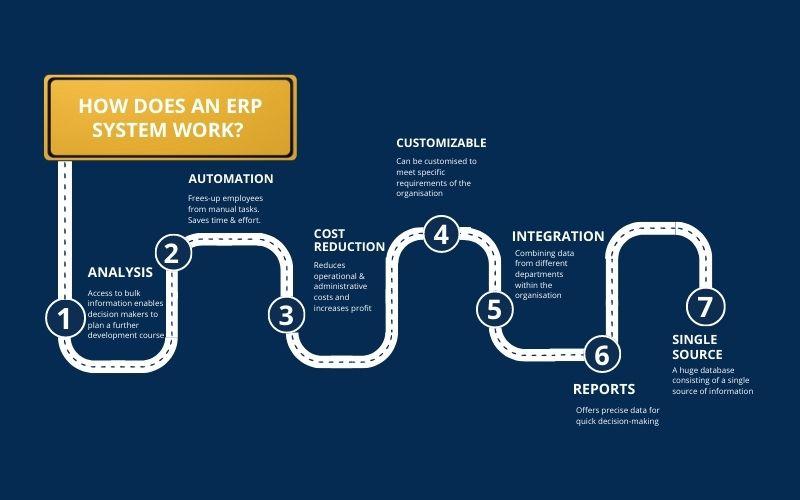
With the ERP system, real-time data can be easily turned into business functions and workflows through all departments. It can deliver outstanding results and ensure on-time delivery and accurate data entry. The ERP vendor can tweak their system to seamlessly integrate their other commonly used solutions, for a cohesive experience.
Top Industries leveraging ERP Software
How Can ERP Improve a Business?
Some prime advantages ERP can offer to businesses involve-
➤ Up-to-date Information
Since ERP applications are consistently receiving data from various departments, it gets updated instantly once the inventory is fetched or a particular shipment is sent to the consumers. It is an added advantage for all decision-makers since they always make a choice depending on the latest available data.
➤ Anytime, Anywhere Data Access
With the ERP system, there is no need to go through a number of paperwork and files. A cloud-based ERP helps warehouse managers to enter data into the warehouse management system, while also analysing patterns and diagnosing the faulty processes that need attention.
➤ Centralised Database
With a centralised database, all decision-makers are on the same platform, since there is no duplicity or conflicting information sources. Additionally, companies shall have the ability to distribute and schedule crucial reports dynamically. You can also easily get access to the detailed information once you generate detailed reports based on it.
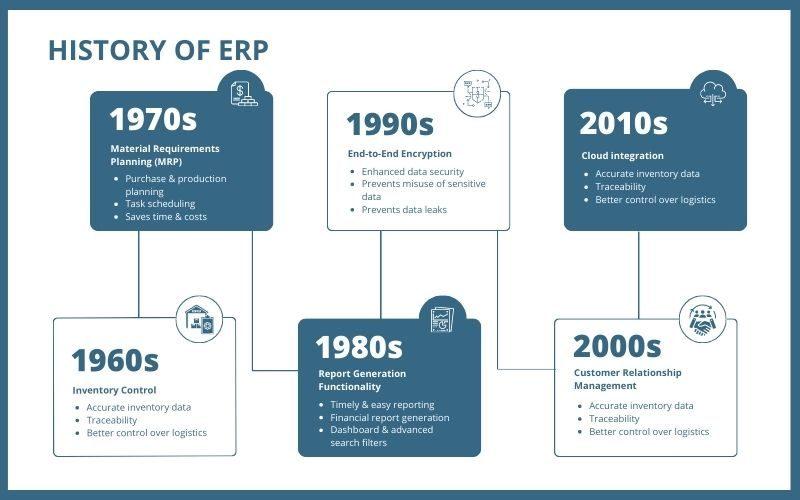
History of ERP
The history of ERP dates back 100 years with the development of Economic Order Quantity (EOQ), a paper-based manufacturing system in 1913. During the period of 1964-1990, EOQ was transformed into an advanced system, Material Requirements Planning (MRP), which provided advanced capabilities. In the 1990s, a full-fledged ERP was developed with modern capabilities.
Business Functions Benefitting from ERP
In every industry, ERP manages several job functions, including-
➤ Supply Chain Management
Employees that are engaged in operations, especially those including inventory planners, warehouse managers, purchasing agents, senior supply chain leaders, etc., depend on ERP for a seamless and continuous flow of products from supplier to customer. They can fetch accurate and detailed information through the system and easily prioritise orders, discard supply chain disturbances, increase timely shipments, check manual processes and more using supply chain management software.
➤ Sales & Marketing
ERP solution is responsible for increasing productivity while gearing for better outputs for the sales team through lead management system. Better results are also expected through the execution of tracking interactions of the company. With the sales management system, sales representatives can easily pen down the discussions and can change the current or past status of the prospects as per the movements in the sales funnel. Once these details are ready, the marketing personnel can manage their insights through every channel. Additionally, they can calculate the efficiency of those messages and channels to allocate adequate budgets.
➤ HR Management
The main use of ERP for the HR department is to track the data of all employees and focus more on workforce trends using the ERP solution. The system can quickly get the contact information and other details for every employee. An HR can also look after various department-wise metrics like average pay by title, retention, and promotion rate to engage their staff in a better way.
➤ Accounting & Finance
Best ERP software in India helps the accounting & finance team track and report every single transaction and other financial data in the system. It also includes payroll, Accounts Receivables (AR), and Accounts Payable (AP). The system helps Financial Planning & Analysis (FP&A) experts convert detailed financial data into predictions as well as report on cash flows, expenses, and revenue.
Besides maintaining and streamlining all accounts and finance-related operations, Sage X3 ERP software also holds the capability to calculate Goods & Service Tax (GST) and Tax Deducted at Source (TDS). The TDS and GST is an add-on feature of the software that helps you eliminate this time-consuming process and calculates TDS and GST at the tip of the finger.
The Future of ERP
The market has continuously fluctuated in recent years, giving a rising call for digital transformation and ‘ERP’ stays at its core. As per the recent survey made by Forbes, ERP is ready to transform the business verticals and also to customize the customer needs, business objectives, and more.
With evolving digital technologies, businesses are quickly changing the way they operate.
Below are the major trends that will be geared in the coming time-
➤ ‘Cloud’ will be top preference
The significance of cloud ERP will be intensified in the future since several companies are looking for ‘anytime’ and ‘anywhere’ access along with minimised cost of technical and hardware support. As per recent reports, more than 60% of companies are choosing cloud software rather than on-premises software.
➤ Industry-specific system
One of the biggest future trends in ERP will be user industry-specific systems. Several suppliers, customers, and employees seek personalised operations to meet their business requirements. The changing workforce and statistics bring no-code and low-code platforms concepts, especially in the manufacturing industry.
These tools help users to get the best customer experience as they wish, instead of learning the new software, which consumes precious time. Also, with the ERP, customers can enjoy personalised dashboards to boost customised chat and workflows, AI-based search, and more.
➤ Two-tier ERP
With two-tier ERP software in India, all small and medium-sized companies can utilize two solutions simultaneously. The concept is best suited for those companies having multiple locations and subsidiaries. The two-tier methodology is on a high edge since it is tied to cloud computing, making ERP systems completely accessible for all organisations.
➤ IoT (Internet of Things)
The Internet of Things establishes connectivity among multiple devices and computer systems. It offers enhanced asset management, forecasting, efficiency, communication, business intelligence and more. The changing consumer behaviour has led to the deployment of IoT in businesses. Hence, it can be observed in varied industries and has become an integral asset for them. This technology is at its peak nowadays, and there is no sign of its downtrend.
➤ Mobile ERP
In the modern tech world, everyone is on their smartphones, tablets, etc., which is why mobile ERP is becoming the most powerful solution in the industry. The mobile ERP can automate processes like marketing, accounting, and business. It also simplifies the interactions to make a few scenarios accessible to the user.Mobile ERPs are designed with a user-friendly interface that can assist users in undertaking their daily business tasks. Employees can complete tasks including time tracking, call logging, cost reporting, and more. Additionally, they can check and view the vital workflow status right from their mobile phones.
The main advantage of mobile ERP is that it offers real-time data and insights, while the general benefits include high productivity, accurate data, remote access, and added flexibility.
ERP Modules
An ERP tool involves several modules having varied features customised for different business aspects. These modules go beyond having finance and other major functions like customer interaction and supply chain management.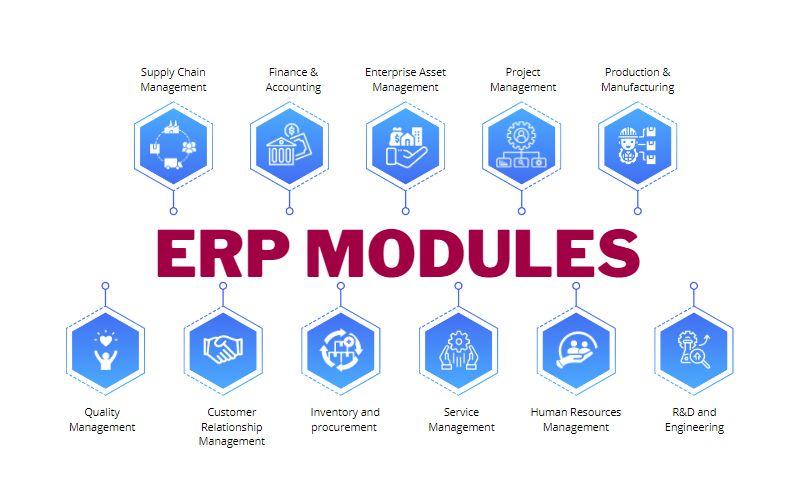
Let’s have a quick look at the widely used ERP Modules:
1 – Supply Chain Management
The supply chain management software helps businesses monitor the supply and goods movements throughout the supply chain. It also undertakes various other business operations like transportation, logistics, warehousing functions, real-time inventory management, etc. It makes the supply chain a completely transparent process and increases flexibility.
2 – Finance & Accounting
The finance and accounting module is one of the essential ERP modules which helps companies to understand their financial status and build their future vision. The key functions of of ERP accounting software include managing the General Ledger (GL), Accounts Receivables (AR), and Accounts Payable (AP). It creates and stores major financial documents such as payment receipts, tax statements, balance sheets, and more.
AR Automation can quickly automate operations related to cash management, vendor payments, etc., aiding the accounting team to close their books on time and match with the present revenue recognition levels.
3 – Enterprise Asset Management
EAM module (enterprise asset management) helps asset-related businesses reduce downtime by maintaining their equipment and machinery to run at the highest productivity levels. This asset management software revolves around predictive maintenance, asset operations, health & safety, environment, scheduling, and more.
Asset management software offers the ability to monitor purchase and placement of assets, preventive maintenance functions, asset devaluation, and monitor assets. Some additional capacities of the module include offering complete support for inventory and warehouse management business functions.
4 – Project Management
The project management module of ERP helps industries in managing projects along with their details. It involves managing and organising the raw material, tracking project status, accounting for needs, etc. All details with respect to the project are saved in the records of this module.
5 – Production & Manufacturing
Manufacturing is a key element of the ERP model. Today, enterprise resource planning systems have a manufacturing execution system or production management system. The manufacturing module aids manufacturers in the industry to precisely plan production while making sure that they have all materials needed to execute the planned production operations.
While the manufacturing process is going on, the ERP software for manufacturing can easily upgrade the current status of all the goods that are in process while assisting organisations in monitoring the current output as compared to the predicted output.
This is among the major ERP components that can also offer an instant image of the shop floor while fetching data on items in progress and also of the finished products. It can also analyse the time required to generate an item and compare its supply with the predicted demand. This helps plan the production as per the market requirements.
6 – Quality Management
The quality management module of ERP system checks and maintains the quality of the manufactured goods as per the certification standards. It also helps to analyse various checkpoints to monitor the quality while preventing defects in manufactured products.
7 – Customer Relationship Management
The CRM software, one of the key ERP components, saves all customer and prospect information in the database. The data also includes all communication history with the customers along with the time, date, and emails. The CRM software can enhance customer service since the employees can easily access all data as and when needed.
A number of companies use the CRM ERP module to manage and organise sales opportunities and leads. It monitors communication with the prospects while guiding executives on which customers should be targeted for specific promotions. Some CRM modules may also offer customer segmentation along with advanced reporting tools.
8 – Inventory and procurement
The procurement software helps manage the purchase of finished goods or raw materials. It can automate PO (purchase orders) and quote requests. When it is linked with a demand planning feature, it can also reduce under-buying and over-buying situations.
The inventory management software can display various inventory levels below the SKU levels by updating the numbers in real-time. It also measures important metrics related to the inventory. It helps to optimise stock based on future and present demands.
9 – Service
The service module of an ERP system helps organisations deliver a customised and trustworthy service as per the customer expectations. It involves various tools for field service management, service-based revenue streams, spare parts, in-house repairs, etc.
It also offers detailed analytics to assist service executives as well as technicians to quickly resolve issues while enhancing customer retention and bringing loyalty.
10 – Human Resources Management
HRM (human resource management) module includes features of workforce management application and delivers some add-on capabilities. HRM acts just like a customer relationship management module for employees. It has precise records of every employee and can also store important documents like job descriptions, performance reviews, and more. It can effortlessly track leaves, hours worked, and paid time off, etc.
The biggest benefit is that the HRM module eradicates inaccurate data by avoiding a lot of duplicate data that is usually stored in different spreadsheets. Overall, it offers everything from employee analysis to employee experience management.
11 – R&D and Engineering
R&D and Engineering is one of the most exclusive modules that offers tools for product development and design. It also offers tools for product compliance, PLM (product lifecycle management), etc. This way companies can create new inventions quickly. The module helps companies in minimising the time to market for all new products and services leading to gains.
With this module, you can easily integrate with all departments that sell, service, and manufacture products with reduced cost and provide the highest quality. It offers the ability to monitor purchase and placement of assets, preventive maintenance functions, asset devaluation, and monitor assets. Some additional capacities of the module include offering complete support for inventory and warehouse management business functions.
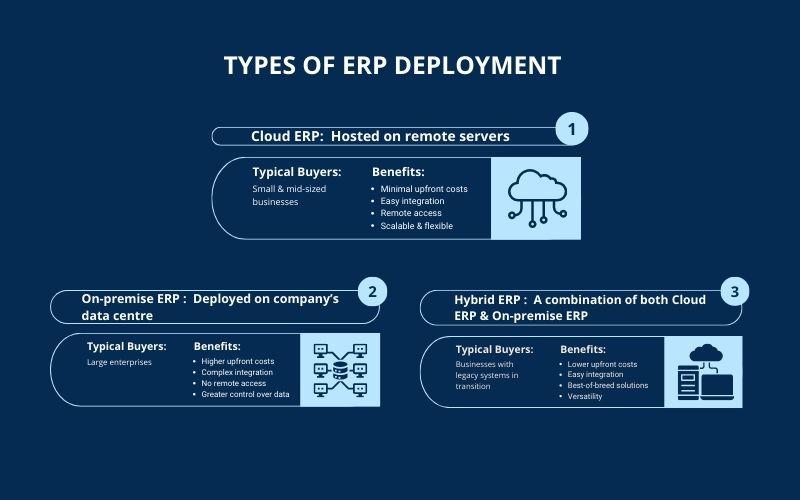
Types of ERP Deployment
ERP systems can be implemented in a number of ways, such as in private cloud, public cloud, and on-premise, or even in various hybrid scenarios having different environments. These types of ERP software can be deployed as per the business requirements. Let us see the notable benefits of each type of ERP deployment which would suit your business the most.1 – Cloud ERP
The cloud ERP software is hosted in the cloud while it is delivered over the internet as a service. The cloud-based ERP solution provider looks after the regular maintenance, security, and updates. Today, cloud ERP is the best deployment method owing to its huge benefits like minimal upfront costs, easy integration, high agility and productivity, etc.
2- On-premise ERP
On premise software helps you control everything and is considered as the traditional model to deploy the software. The ERP system is installed in the data centre at your preferred location. The maintenance and installation of the software is the responsibility of the team. Today, a number of companies that have been deploying on-premise ERP systems are upgrading to cloud ERPs due to the agile nature.
3- Hybrid-ERP
Hybrid ERP is especially relevant for those companies who are looking for the benefits of on-premise and cloud ERP deployment to meet their business needs. Here, some applications and data will be saved in the cloud and the rest will be saved on-premise as per the company requirements. Usually, hybrid-ERP is referred to as a two-tier ERP system.
4- Open-source ERP
Open source ERP is a very cost-effective and free option suitable for some organisations. A lot of open-source ERP providers help companies to implement their software free of cost. Also, they may charge a very minimal annual fee in case the user needs cloud access.
Features of ERP
An advanced ERP can have a number of functionalities as per the modules they have and the industry standards they cater. Below are the most important features that all ERP systems should have-➤ Centralized Database
The system should have a common database having centralised information offering 360 degree view of the organisation. Also, it should have consistent and shared data. This single source of real time information removes the need to manually merge various databases.
➤ Data visualisation
It is one of the vital features of ERP that showcases the visual presentation of important information through KPIs, dashboards, etc and also helps in making informed decisions.
➤ Automation
This key feature of ERP software has the ability to automate redundant tasks including invoicing, reporting, processing, payroll, and more. It reduces manual duplicacy and manual data entry, reducing errors, and saving some time. With automation, your staff can focus on the important tasks that take advantage of their skills and knowledge.
➤ Stable Interface
Throughout all roles and departments, every team member uses the same user interface and has the same user experience with the ERP system. For example, modules for inventory management, finance, and HR look the same and have the same shared functionality. A stable UX/UI can give you efficiency profits.
➤ Data analysis
ERP surpasses all data silos. Whenever you try to mix and match data from any specific part of your business in insightful reports, you are keeping focus on the outperformed areas along with those failing to fulfil expectations. The team executives can then check the issues and resolve them instantly.
➤ Deployment choice
This must have feature is one in which users should choose the type of the system they want to deploy at their workplace. They can choose from Cloud, hybrid, and on-premise systems.
Benefits of ERP
An advanced ERP can have a number of functionalities as per the modules they have and the industry standards they cater. Below are the most important features that all ERP systems should have-Key advantages of ERP Solution include
➤ Cost Savings:
Due to increased efficiency, streamlined processing, and lower operational costs, businesses can avoid unnecessary expenditures, leading to cost savings.
➤ Improved productivity
Automate and streamline your major business operations so that companies can work more with less resources’ availability .
➤ Reduced risk
Increase business visibility as well as control. Also, ensure compliance with all regulatory requirements while also preventing risks in the future. With advanced safeguards in place, ERP systems also help in risk mitigation by maintaining the data integrity of financial and other records.
➤ Seamless IT functions
Through integrated ERP applications with a centralised database, your business can enjoy simplified IT functions.
➤ Greater flexibility
With real-time access to data and effective functions of the ERP solution, you can identify and respond to new opportunities quickly.
➤ Quick reporting
Quickly track business and financial reporting while sharing reports flawlessly. You can also enhance performance in real time with the right usage of the ERP function.
➤ Transparent workflow
Since all workflows and information is saved in one place, employees can access the data anytime anywhere without asking for the updates from the employees constantly.
➤ Data security & regulatory compliance
The industry-specific data security regulations and financial reporting standards change often and hence it is essential for companies to stay up-to-date with them. One of the major benefits of ERP systems is that it can aid your company in staying fully compliant with these changes while also keeping all business data secure.
ERP Implementation
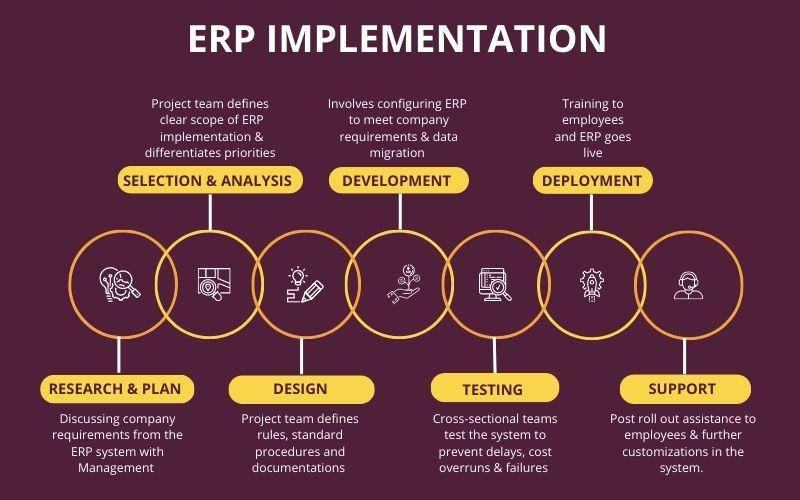
7 Steps of ERP Implementation
Preparing well for the ERP implementation process will pay off for sure and companies can also avoid key challenges by preparing a detailed plan of the ERP implementation.
Below are the major stages of the ERP implementation process-
1 – Research & Plan
One should get the cross functional team on the same page and then, discuss and analyse what are the company requirements from the ERP software. The prime function of this team would be to chalk out poor processes along with the obstacles to business growth.
2 – Selection & Analysis
Once the team has all required documents, it should analyse the offerings and choose the suited platform that can solve the existing issues in the system. It should meet every need of the department while augmenting the company’s growth.
3 – Design
In the designing phase, the ERP implementation team checks if the system can withstand the existing configurations and workflows and also checks which processes should be amended. This is the perfect phase to check for any customizations requirements.
4 – Development
During the development phase, expert technical professionals configure the software to achieve the desired goals. They also start migrating the organisations’ data to the new system. This phase also lets you decide how the employees will be trained and start scheduling sessions to get the required outputs.
5 – Testing
This is a step which should not be skipped for any reason. The testing phase makes sure that everything needed is working as expected so that you can repair any problems before they occur in the future. It is highly advised that all cross-sectional teams should be present while testing the system.
6 – Deployment
The deployment phase is the ‘go-live’ phase. Companies should train their employees and guide them to accept the change in the system functions. Some companies choose to roll out all modules at a time while some choose to release a few modules at the beginning.
7 – Support
The support stage is the ERP implementation strategy which ensures that the users can take the advantage of the ERP system and may also include some additional configurations.
Cost of ERP
The cost of ERP depends on the vendor, deployment model, and modules. Usually, the total cost of ERP software may range from $10,000 to a million dollars each year.
Cloud-based ERP, specially SaaS options, have reduced upfront costs as compared to on-premises software. As mentioned earlier, the ERP cost is also based on the modules your business requires. The final solution may have basic functionality for basic order or inventory management functionality. And if modules are customised, they will incur some additional fee.
In the case of on-premise ERP solutions, organisations can buy a permanent licence which is costlier, when compared to cloud-based options. But it is just a one time expense. With SaaS products, the cost of the software will change based on the number and type of modules requirements. To host this software, on-premises software users pay for the servers along with the infrastructure to host the system.
A hybrid ERP software is more expensive than the other options since it needs a lot of resources to support on-premises ERP, along with the additional subscription fees for cloud apps.
Finally, the ERP cost is different from their licensing. When making calculations of TCO of different ERP solutions, operating expenses with respect to customization, training, upgrades, support, and maintenance are considered. However, these costs will change as per the providers. It is highly advised that you should ask a lot of questions to get a good estimate of the total expense.
How to Choose the Right ERP Software for your business?
There are a number of factors that should be considered while selecting an ERP solution. These factors include company size, deployment model, and required capacities.
One should always look for those vendors having proven records of successful working with companies in your space. Checking for true success stories and asking for reference customers will also help you in finding the right software.
Additionally, one should consider the ERP software provider’s roadmap for latest technologies like blockchain, IoT, Artificial Intelligence, and more.
You should start with those modules that are important to your business. For example,, companies can start with the finance module to automate main accounting operations. Similarly, companies having a larger number of employees should consider HRM (Human Resource Management) systems for improved employee experience and enhanced company reputation.
Finally, choosing ERP packages for your company should be one which will be scalable enough to enhance the features and modules that can help you grow your business.
While choosing an ERP solution, follow these steps to save time and money as well as avoid errors:
When Should You Implement ERP Systems?
There is no one-size-fits-all answer to this question, as the decision of when to implement an ERP system depends on a variety of factors specific to each business. However, some key indicators that it may be time to invest in an ERP system include:
1. Your company is experiencing growth and needs a system that can scale with it.
2. You are having difficulty tracking inventory or managing orders.
3. You are experiencing inconsistency in data across departments.
4. You are struggling to keep up with customer demands.
5. Your business is complex and you need a system that can handle its specific needs.
If your company is experiencing any of these issues, it may be time to consider implementing an ERP system. Talk to a trusted consultant to help you analyze the pros and cons of making the investment and determine if an ERP system is right for your business.
ERP Integration
Currently, ERP software offers a broad range of business functionalities while still it needs to sync with other applications like CRM, HCM software, industry-specific solutions, e-commerce platforms, as well as other ERP systems. With proper ERP integration, businesses can gain a clear view of data from various systems and enhance business process effectiveness. It can improve customer experiences while facilitating connection across all departments as well as business partners.
The advanced ERP systems are quite agile in nature and can be easily integrated with a broad array of software product APIs (Application Programming Interface). Some other methods for ERP integration involve iPaaS (integration platform as a service) and ESB (enterprise service bus).
iPaaS technology can quickly sync cloud ERP software/ on-premise ERP software from third parties or from the same vendor. These platforms require very low coding or even no-coding and are very inexpensive and flexible.The major advantages of iPaas include a wide array of users including IoT, automatic API generation, prebuilt content, and more.
One vital information that needs to be considered when it comes to ERP integration is that the more data is fed into the ERP system, the more value the system shall give.
Limitations of ERP
Though ERP offers value to companies in all ways, companies may also face some challenges while implementing it or even developing a building case for the system. So, it is crucial to understand the blockages prior to adopting an ERP system. However, it is to be considered that these blockages can be removed by having a detailed plan and by choosing an appropriate ERP vendor.
Things to keep in mind before you get ready for ERP implementation-
1 – Cost of the system-
Due to its high cost even in the earlier days, ERP systems were deployed only by large organizations. But, the scenario has changed since a couple of decades. Today, the system is quite affordable due to SaaS-based software, while more solutions are specifically designed for SMEs.
2 – Training requirement-
Anyone who is planning to use an ERP system requires a certain level of training. Though employees may show resistance in the initial stages, it is equally important to train them with step by step instructions.
3 – Complexity-
An ERP solution has a lot of features which could increase your workforce pressure at times. But, ERP vendors nowadays focus on enhancing the user experience which makes the system usage even more simpler. Also, since employees require access to only those tools in the system that are relevant to their jobs, the system becomes much more accessible.
4 – System maintenance-
Regular maintenance might be one of the disadvantages of ERP. In the early days, maintaining an ERP software was an expensive task which is why small scale businesses refrained from using it. Apart from the IT staff and security members, businesses may also pay third-party service providers or even vendors for expert suggestions. It is advised that companies should check the appropriate supplier who will offer a perfectly managed SaaS system.
5 – Inefficiency in resolving policy issues-
Some error-prone processes won’t be necessarily managed by an ERP. The software may display operational issues while helping you find better methods to resolve them. The same case applies for company policies too. You have to make amendments in the policies that should configure the system so as to support advanced methods of making business profits.
6 – Costs of data conversion-
While switching to an ERP system, you should convert some of the data in a compatible format that would go with the platform. But this process would result in unexpected expense and delays in the processes. So, it is essential to review your database thoroughly and work with your IT team. It will help in identifying crucial data compatibility problems.
Looking for top ERP software provider ?
Talk to our ERP experts!
Get Free Consultation
+91-93422 58771
Send queries to
info@banibro.com

Schedule Product Demo